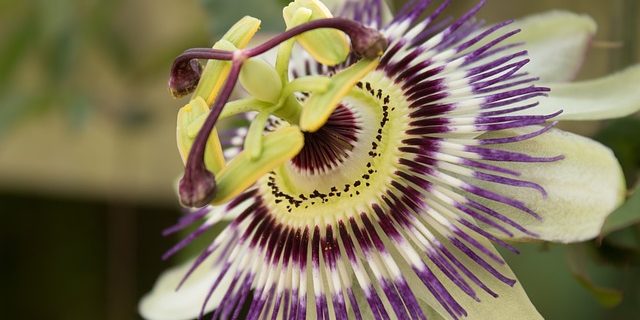Passion Flower’s fantastic beauty is a medicine in itself, but this lovely vine has much more to offer than its stunning, dramatic blooms.
This time of year in the garden, Passion Flower vines are 4-5 inches tall with a few tiny leaves. But given time, sunlight, and water, they will climb as high as any trellis you can provide for them and produce a bountiful supply of flower buds and leaves that can be snipped and made into a powerfully relaxing brew.
Passion Flower is a sedative herb for both body and mind. It is a classic herb for treating insomnia and is especially effective when combined with Valerian and Ashwagandha. Passion Flower’s specialty is in stopping patterns of racing, circular thoughts, especially when trying to fall asleep. It helps re-establish normal sleep patterns without a “hangover” effect. This herb has a reputation for bringing on vivid dreams, and this reputation is well-founded. Sometimes the dreams can be overwhelming, especially as the herb has the ability to help uncover repressed memories. The fresh tea brewed from flower buds is especially powerful, so start slow if you’re making your own. For the strongest effect, the buds should be clipped just before blooming.
Passion Flower soothes nervous tension and is quite healing to the nervous system; it can be very effective in treating the nerve pain associated with neuralgia and shingles. In addition to its sedative effects, Passion Flower also has powerful anti-spasmodic properties. It has been employed in cases of seizures, Parkinson’s disease, epilepsy, and asthma with great success.
It’s important to experiment with Passion Flower to see if it’s the right relaxant for you. Everyone is different, and issues of insomnia and stress are always complex and personal. You’ll be able to tell if Passion Flower is a good match for you by how it makes you feel. And if it doesn’t work for you internally, you can always grow the plant and enjoy its beautiful flowers (or try it on your friends).
Passion Flower loves our DC area climate and will grow enthusiastically with full/partial sun and lots of water. All you need is a pot, some soil, sunshine, and something for the vines to climb. Bees and other pollinators will thank you. In fact, they will sing your praises. Carpenter bees especially love Passion Flower nectar and can often be found drowsing in the blossoms, half-asleep from the flowers’ soothing, sedative effect. In our generous climate, Passion Flower is perennial and will return year after year. There are many different varieties, up to 400. We grow Passiflora incarnata at the shop, but I have read that Passiflora edulis has a better-tasting fruit, so maybe we’ll give it a try next season.
Passion Flower’s name comes from the delicate corona in the center of the blossom, said to resemble the Crown of Thorns from the Passion of the Christ. The vines climb to great heights, and they will cover their foliage with a wealth of beautiful flowers. Their three-to-five lobed, deep green leaves have a warm, nutty scent and can be brewed in a relaxing tea along with the flowers. But it’s the blossoms that really hold the medicine, especially the buds cut just before blooming.
Passion Flower will continue to produce buds and flowers all summer long, so you’ll have more than enough to cut for medicine while still allowing plenty to bloom so you can enjoy the gorgeous, dramatic flowers and subsequent Passion Fruit. The Passion Fruit has flesh-covered seeds that can be sucked like pomegranate seeds. The fruit itself is nutritive and diuretic (and tasty, above all). Passion Fruit is rich in flavonoids, which are powerful antioxidants and anti-inflammatories, and which boost immune function to a remarkable extent. The fruit doesn’t always ripen completely in our agricultural zone, but it’s still edible and sweet to taste.
In Passion Flower, you’ll have an herbal friend as beautiful as it is medicinal, year after year.








